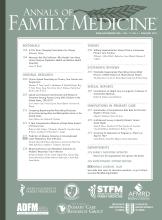Health system change is a now a reality in the United States and presents opportunities for family medicine to contribute rational solutions to the twin problems of high cost and variable quality confronting American health care. Academic health centers in particular will need to change if they are to survive and continue to make vital contributions to patient care, discovery, and educating tomorrow’s health care workforce. Achieving the triple aim of improving the processes of care, improving the health of populations, and containing costs presents unique challenges to the siloed environments of academic centers.1 Can family medicine academic departments lead the way in health system change, and if so how?
The theme of the 2013 Association of Departments of Family Medicine (ADFM) Annual Winter Meeting was “Leading in the Time of Transition from Volume-Based to Value-Based Health Care.” As part of this meeting, ADFM members engaged in workgroup discussions around 4 major themes: creating a strong partnership with the academic medical center (AMC); improving quality and reducing costs for patients, employers, and payers; collaborating effectively with other specialties; and improving the practice of family medicine and preparing the family physicians of the future.2 Following this session, a white paper with specific recommendations for how departments of family medicine (DFMs) can play a leading role in helping the nation with the transition to value-based health care was produced and shared with ADFM members.3
To ascertain how DFMs are meeting the challenge of health system change in their local environments—and the degree to which change has been implemented—questions about each of the specific recommendations were asked on the 2013 version of ADFM’s annual member survey. Chairs of all 150 department members of ADFM, which include virtually all allopathic medical schools plus some osteopathic medical schools and large regional medical centers were invited to complete the survey. The survey included a number of other topics of interest to ADFM and DFMs and was sent electronically to department chair members using an online survey tool (Catalyst). The survey was open for 2 full months with regular reminders to those who did not complete the survey. The final response rate was 78%.
Among the 117 respondents, 94% were from allopathic medical schools; 74% from public institutions; and 47% from large schools (>149 students matriculating per year). A roughly equal number of respondents have been a department chair for more than 8 years (39%) as those that have been a department chair for 3 years or less (38%).
For the questions about the recommendations from among the 4 themes in health care transformation noted above, respondents were asked to “choose where your department is on each item” and were given the following options: not feasible in our setting; planned but not started; piloting and/or in development; implemented—up and running.
Overall, DFMs across the country are playing a leading role in health care transformation. The changes that the most DFMs have currently implemented are: moving to team-based care in practices (47%); improving delivery of preventive services (42%); efforts to reduce avoidable hospital readmissions (35%); making more appropriate use of consultations and referrals (32%); and attracting and successfully managing care for a large base of primary care patients (28%).
In addition to these changes that have already been implemented by many, a majority of responding DFMs (50% or more) have either planned but not started or are piloting methods to: reduce and control post-acute care costs; reduce unnecessary and duplicative testing; reduce both non-medical and medical costs for commercially insured patients; deliver more non-visit–based care; manage outcomes for populations of patients; and coordinate primary and specialty care for complex patients.
Most respondents considered reducing low margin admissions to be unfeasible in their setting (40%); several commented that this is a factor of current reimbursement models. A number of respondents also noted that they are not in an Academic Medical Center. Lastly, a roughly equal number of respondents have implemented efforts aimed at improving maternity care outcomes as the number who indicated that improving maternity care outcomes was not feasible in their setting (29% and 26%, respectively).
These findings suggest that many DFMs are already engaged in taking significant actions to help their institutions confront the necessary changes to deal with health system transformation. Whether more DFMs can take the lead and participate in these and other opportunities for leadership over time—particularly as pilot programs evolve and payment reform initiatives continue—remains to be seen, but many departments are off to a promising start.
- © 2014 Annals of Family Medicine, Inc.







